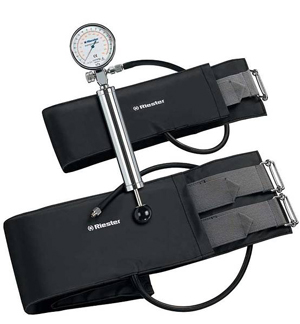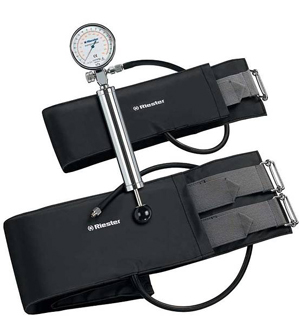TOURNIQUET, pneumatic, ARM-CUFF + MANOMETER + LEG CUFF
Valid Article
TOURNIQUET, pneumatic
Definition
Broad band of fabric with inflatable bladder, connected on one side to an inflation bulb, and on the other side to a manometer for measuring the pressure.
Wrapped around a limb and inflated, this device allows to reduce or totally occlude circulation in order to carry out some surgical gestures or an intravenous loco-regional anaesthesia.
Specifications
Components
- 1 arm cuff
- 1 leg cuff
- 1 hand pump
- 1 manometer with tubing and connectors
Quality standards
Technical specifications
- Arm and leg cuff:
- Broad band of washable gabardine
- Velcro fastening
- Arm cuff dimensions: ± 100 x 9 cm
- Leg cuff dimensions: ± 140 x 10 cm
- Internal inflatable rubber bladder
- Manometer:
- Case made of ABS with alloy aluminium bottom
- Dial with analogical pressure display
- Graduations in mm or cm Hg, from 0 to 600/700 mm (or from 0 to 60/70 cm) of Hg
- Connected to the arm cuff and the leg cuff by a rubber tube
Instructions for use
Before use
- Check the bladder positioning into the cuff (PATIENT SIDE) before placing the tourniquet on the patient's limb.
- Check the velcro fastening (if needed, add an elastic bandage).
- Check that the bulb and the manometer function properly.
- Check the pressure gauge of the manometer.
Operation of the tourniquet:
- close the release valve by turning it clockwise
- screw tube connector at the end of the cuff tube into the tube socket on the manometer housing
Applying the cuff:
- Place the cuff around the respective limb and tighten the straps on the cuff by pulling them through the metal buckles
- the tube exit should be approx. in the centre of the limb to be treated.
Operating the pump:
- hold the pump in one hand and, using the other hand, carefully pull the air pipe of the pump on the black plastic ball (3.9.) up to the stop and then push it back into the valve.
- Repeat the pumping action until the manometer scale shows the desired value.
- to restrict blood circulation to the arm: +/- 250 mm Hg
- to restrict blood circulation to the leg: +/- 550 mm Hg
- the pressure which the manometer shows must be continuously supervised during application and, if necessary, be corrected by after-pumps.
Precautions for Use
Should only be used by experienced staff (the tourniquet should be properly applied, the time of installation should be noted, the appropriate pressure for arms and legs should be respected).
Inflation time should be kept to a minimum to minimize risks to the patient
Avoid tube clamping with traumatic forceps of Kocher type. If the valves are working well and the tourniquet is well applied, clamping is unnecessary, and even harmful.
Maintenance
Must be cleaned with soapy water after each use and kept in good working order.





![[KMEDKHOE1CO] OPERATING SUITE, PART med.equip. 2 operating rooms, complete](/web/image/product.template/572536/image_256/%5BKMEDKHOE1CO%5D%20OPERATING%20SUITE%2C%20PART%20med.equip.%202%20operating%20rooms%2C%20complete?unique=80d20b8)
![[EANETOUR2IA] (tourniquet pneumatic) ARM CUFF](/web/image/product.template/569300/image_256/%5BEANETOUR2IA%5D%20%28tourniquet%20pneumatic%29%20ARM%20CUFF?unique=7a4dd98)
![[EANETOUR2IL] (tourniquet pneumatic) LEG CUFF](/web/image/product.template/569297/image_256/%5BEANETOUR2IL%5D%20%28tourniquet%20pneumatic%29%20LEG%20CUFF?unique=d7b37f0)
![[EANETOUR2IM] (tourniquet pneumatic) MANOMETER](/web/image/product.template/569840/image_256/%5BEANETOUR2IM%5D%20%28tourniquet%20pneumatic%29%20MANOMETER?unique=92612a4)
![[EANETOUR2IP] (tourniquet pneumatic) HANDPUMP](/web/image/product.template/569855/image_256/%5BEANETOUR2IP%5D%20%28tourniquet%20pneumatic%29%20HANDPUMP?unique=92612a4)